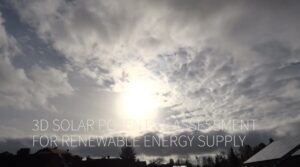Watch the video: http://youtu.be/TaCUaG5XEas
We use methods like laser scanning and GIS in combination with computer science to simulate the sun’s path and the respective shadows that are cast by 3D objects. Thereby, we can assess the solar potential for certain areas and surfaces. Solar potential assessments can play a crucial role in studies that have a connection to solar irradiation. The case studies presented in the video include an examination of highway noise barriers concerning their suitability for producing energy via solar panels, and the estimation of real estate value when taking into account solar income at a real estate object. Through the ability to use 3D models for shadow analyses, studies using 3D geodata are of higher quality than common 2D shadow simulations since even shadows of non-solid obstacles like vegetation can be calculated. Methods dealing with 3D geodata will become more important in the future especially for countries that try to shift to renewable energy supply and therefore need accurate evaluations of solar potential.
Further reading:
- Helbich, M., Jochem, A., Mücke, W. & Höfle, B. (2013): Boosting the Predictive Accuracy of Urban Hedonic House Price Models Through Airborne Laser Scanning. Computers, Environment and Urban Systems. Vol. 39(0), pp. 81-92.
- Höfle, B. & Jochem, A. (2012): 3D Laser Scanning Point Clouds and GIS – Current Developments. gis.SCIENCE. Vol. 25(2), pp. 91-100.
- Jochem, A., Höfle, B. & Rutzinger, M. (2011): Extraction of Vertical Walls from Mobile Laser Scanning Data for Solar Potential Assessment. Remote Sensing. Vol. 3(4), pp. 650-667.
- Jochem, A., Höfle, B., Rutzinger, M. & Pfeifer, N. (2009): Automatic roof plane detection and analysis in airborne LIDAR point clouds for solar potential assessment. Sensors. Vol. 9(7), pp. 5241-5262. MDPI Publishing



